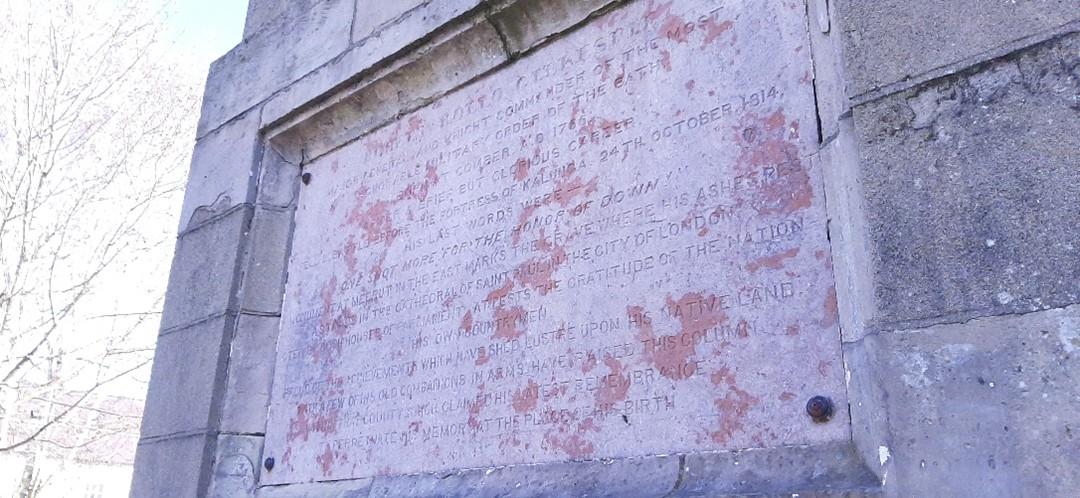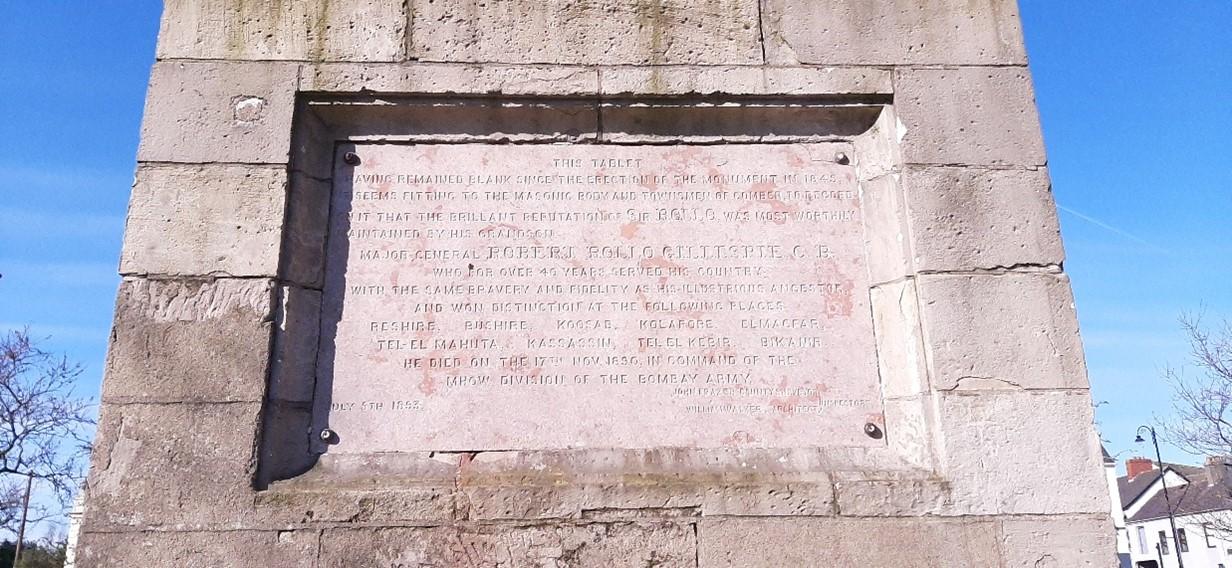
Rollo Gillespie Monument – Comber Square
Sir Robert Rollo Gillespie (1766-1814)
Born on this site, in Comber Square (house demolished in the 1840s) and baptised in the neighbouring St Mary's Parish Church, Gillespie moved to England aged ten with his family where he was educated before joining the army in 1783.
During his service he saw a great deal of action most notably;
- His first action, as Captain, at Tiburon in West Indies in 1794.
- In 1798 attacked by a band of villains on San Domingo and although badly wounded reputedly killed six!
- In 1806 Gillespie joined the 19th Dragoons in India, stationed at Arcot and while there led his troops to Vellore, taking “vengeance” on the native Indians who had massacred the British garrison there. This is the subject of the poem "Gillespie" by Sir Henry Newbolt.
- With the 8th Royal Irish Dragoons and 25th Light Dragoons and in 1811 took part in an expedition to Java, capturing Batavia, the capital, from the French seeing him promoted to Major-General in command of the garrison on Java.
Gillespie took command of the Meerut Division in India in 1813 and whilst in charge fought against the Ghurkhas in Nepal, perishing on 31st October 1814 whilst attacking the fortress of Kalunga. His last words it is said were, "One shot more for the honour of Down".
His ashes were buried at Meerut and Gillespie was awarded a posthumous knighthood in the 1815 New Year's honours list and in 1820 a memorial was to him was erected in St Paul's Cathedral by a “grateful nation”.
His native Comber decided to erect a monument in his honour with a design competition, won by Mr John Johnston of Armagh who built the monument. The Freemasons were heavily involved, as Gillespie had been a prominent member, and much Masonic symbolism can be seen on it. An interesting fact is that a sealed bottle was deposited when the foundation stone was laid on 24th June 1844 (this being St John's Day, of significance to Masons). It contained newspapers, coins of the realm, an almanac for 1844, the names of subscribers, the architect and contractor and a document outlining the circumstances leading to the erection of the Monument.
The Monument was unveiled on 24th June 1845, with 30,000 people said to have crowded into Comber Square. The Illustrated London News recorded;
The pillar is described as a Grecian Column and stands 55 feet high. It is surmounted by the figure of Gillespie, posed for by a relative. Down the sides are listed the names of his battles. There are four tablets round the base giving information about Gillespie, the Gillespie arms quartered with the badge of the Order of the Bath, and Masonic symbols. A fourth tablet initially remained blank, but later was inscribed in commemoration of another Major General Robert Rollo Gillespie, grandson of the original Gillespie, who died in 1890.
We would thank Ms Martha Payne, genealogist, researcher, and great-granddaughter of Mr John Johnston, in identifying a previous inaccuracy relating to the date of Rollo Gillespie’s death which has been amended accordingly.
Text on tablet on West Face of the Pillar and panel in front of this face of the pillar:
ROBERT ROLLO GILLESPIE
Major General and Knight Commander of the Most Honorable Military Order of the Bath
Born at Comber A.D. 1766
After a brief but glorious career fell in battle before the Fortress of Kalunga 24th October 1814
His last words were –
“ONE MORE SHOT FOR THE HONOR OF DOWN!”
A monument in Meerut in the East marks the grave where his ashes rest
A statue in the Cathedral of Saint Paul in the City of London voted by both Houses of Parliament attests the gratitude of the Nation –
His own countrymen proud of the achievement which has shed lustre upon his native land, with a few of his old companions in arms have raised this column within that county which claimed his latest remembrance to perpetuate his memory at the place of his birth

Text on Tablet on East Face of the Pillar:
This tablet
having remained blank since the erection of the monument seems fitting to the Masonic body and townsmen of Comber, recorded on it that the brilliant reputation of Sir Rollo was most worthily maintained by his grandson –
Major General Robert Rollo Gillespie C.B.
Who for over forty years served his country with the same bravery and fidelity as his illustrious ancestor, and won distinction at the following places
Reshire, Bushire, Koosab, Kolapore, El Magfar, Tel-El-Mahuta, Kassassin, Tel-El-Kebir, Bikanir.
He died on the 17th Nov 1890, in command of the Mhow Division of the Bombay Army.
July 5th 1893 John Frazer, County Surveyor, and William Walker, Architect } Inspectors

You might also like
Online Arts and Heritage Grant Information Session
-
Between Worlds
-
Observational Acrylic / Oil Painting
-
Outreach Class: Watercolour with Bernice Anderson
-
